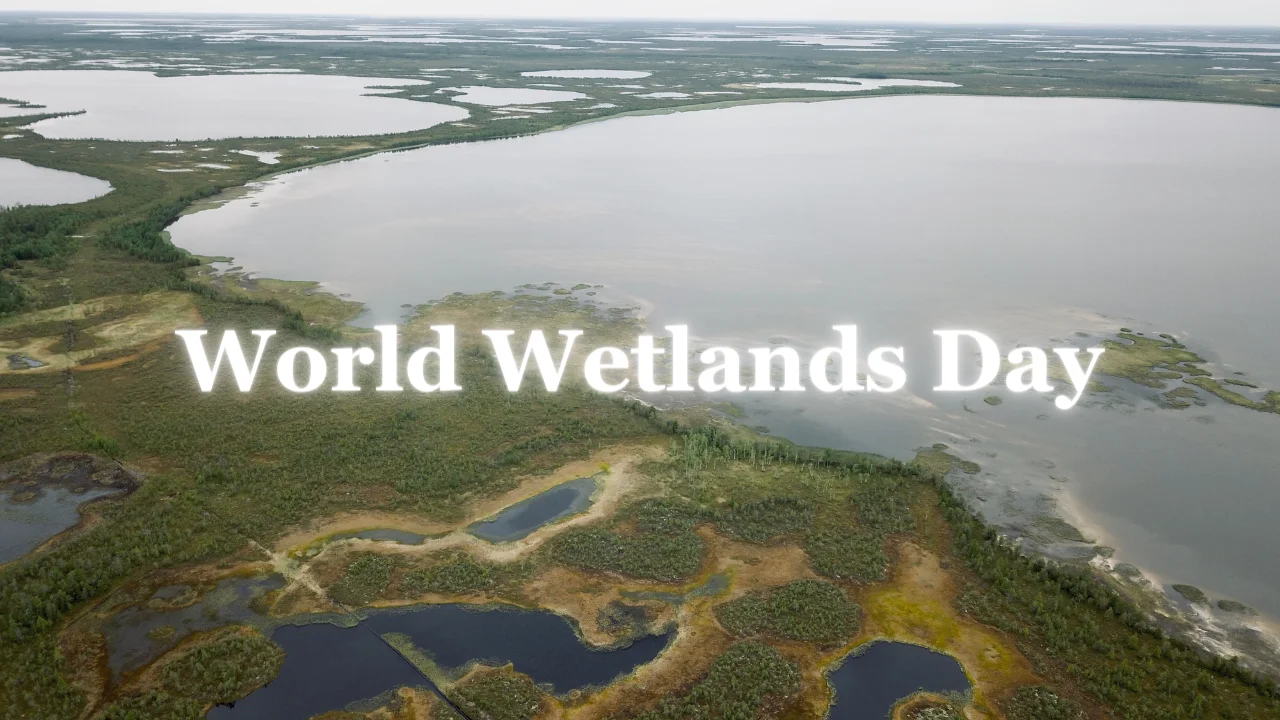World Wetlands Day 2024
World Wetlands Day, celebrated annually on February 2nd, commemorates the signing of the Ramsar Convention on Wetlands in 1971. The day aims to raise global awareness about the importance of wetlands for human well-being and the environment.
World Wetlands Day 2024 Theme
The official theme for World Wetlands Day 2024 is “Wetlands and Human Wellbeing”. This theme emphasizes the critical role that wetlands play in supporting human well-being across various aspects of life.
By focusing on “Wetlands and Human Wellbeing,” World Wetlands Day 2024 will serve as a call to action for individuals, communities, and governments worldwide to recognize the vital importance of wetlands and take concrete steps to protect them for the present and future generations.
What is a Wetland
A wetland is a distinct ecosystem that is flooded or saturated by water, either permanently or seasonally. These areas have unique characteristics that differentiate them from both terrestrial and aquatic environments.
Types of Wetlands
- Marshes: Dominated by herbaceous plants like reeds and grasses.
- Swamps: Dominated by woody plants like trees and shrubs.
- Bogs: Peat-forming acidic wetlands with low nutrient levels.
- Fens: Peat-forming wetlands with higher nutrient levels.
- Estuaries: Where freshwater meets saltwater, creating a unique ecosystem.
Importance of Wetlands
- Water purification: Filter pollutants and impurities from water.
- Flood control: Absorb and store excess water, reducing the risk of floods.
- Climate change mitigation: Act as carbon sinks, storing carbon dioxide and reducing greenhouse gas emissions.
- Biodiversity hotspots: Provide habitats for a wide range of plants and animals.
- Economic benefits: Support tourism, fisheries, agriculture, and other economic activities.
- Cultural significance: Hold cultural and spiritual importance for many communities around the world.
Threats to Wetlands
- Pollution: Runoff from agricultural land, factories, and urban areas pollutes wetlands and harms their ecosystems.
- Habitat destruction: Draining, dredging, and filling wetlands for development destroys critical habitats for plants and animals.
- Climate change: Rising sea levels, changes in precipitation patterns, and increased temperatures threaten the health and survival of wetlands.
Wetlands and the SDGs
Wetlands play a crucial role in achieving several Sustainable Development Goals (SDGs).
- Goal 6, focuses on ensuring the availability and sustainable management of water and sanitation for all, particularly targets 6.6, emphasizing the protection and restoration of water-related ecosystems.
- Goal 14, centered on the conservation and sustainable use of oceans, seas, and marine resources, includes target 14.2, which advocates for the sustainable management and protection of marine and coastal ecosystems.
- Additionally, Goal 15, addressing life on land, highlights target 15.1, which aims to ensure the conservation, restoration, and sustainable use of terrestrial and inland freshwater ecosystems and their services.
History of World Wetlands Day
On August 30, 2021, the UN General Assembly declared February 2 as World Wetlands Day. It brings attention to the urgent need to reverse the accelerating loss of wetlands and promote their conservation and restoration. This date commemorates the adoption of the “Convention on Wetlands of International Importance” in 1971 in Ramsar, Iran, on the shores of the Caspian Sea.
The Ramsar Convention, adopted by 172 countries, facilitates the protection and wise use of wetlands through the designation of protected areas, effective policies, and the exchange of knowledge. Each country joining the Convention must designate at least one wetland to be included in the List of Wetlands of International Importance, known as Ramsar sites.
Ramsar Convention
The Ramsar Convention on Wetlands of International Importance Especially as Waterfowl Habitat, also known as the Convention on Wetlands, is an international treaty that provides the framework for national action and international cooperation for the conservation and wise use of wetlands and their resources.
Background
- Adopted: February 2, 1971, in the Iranian city of Ramsar.
- Entered into force: December 21, 1975.
- Signatories: 172 countries (as of October 26, 2023).
Objectives of the Ramsar Convention
- To stop the worldwide loss of wetlands and promote their conservation.
- To promote the wise use of wetlands and their resources.
- To cooperate internationally on wetland conservation and management.
Key Features of the Ramsar Convention
- Site designation: Contracting parties designate wetlands for inclusion in the List of Wetlands of International Importance (Ramsar List) based on their ecological, biological, cultural, or hydrological significance.
- Wise use principle: Promotes the use of wetlands in a way that ensures their long-term sustainability and the benefits they provide to humans and nature.
- International cooperation: Encourages collaboration among countries to share knowledge, expertise, and resources for wetland conservation.
Benefits of the Ramsar Convention
- Wetland conservation: Provides a global framework for the conservation and wise use of wetlands.
- Biodiversity protection: Protects critical habitats for a wide range of plants and animals.
- Water resources management: Helps to regulate water supplies and control floods.
- Climate change mitigation: Wetlands play a role in storing carbon dioxide and reducing greenhouse gas emissions.
- Economic benefits: Wetlands support tourism, fisheries, and other economic activities.
Challenges
- Wetland loss and degradation: Wetlands continue to be lost and degraded due to human activities such as agriculture, pollution, and infrastructure development.
- Climate change: Climate change poses a significant threat to wetlands, with impacts such as rising sea levels and changes in precipitation patterns.
- Lack of resources: Many countries lack the financial and technical resources needed to effectively implement the Ramsar Convention.
The Ramsar Convention plays a vital role in protecting and conserving wetlands around the world. It provides a framework for international cooperation and action. It helps to ensure that wetlands are used wisely and sustainably for the benefit of present and future generations.
Significance of World Wetlands Day
- Highlighting the benefits of wetlands: The day aims to highlight the diverse benefits that wetlands provide to humans, including flood control, water purification, climate change mitigation, and support for biodiversity.
- Promoting the conservation and wise use of wetlands: The day encourages people to take action to conserve and use wetlands sustainably. It ensures their long-term survival and the benefits they provide for generations to come.
- Raising awareness about threats to wetlands: The day aims to raise awareness about the threats wetlands face, such as pollution, unsustainable land use, and climate change.
- Encouraging action to address wetland threats: The day encourages individuals, communities, and governments to take concrete actions to address threats to wetlands and promote their conservation.
2nd February 2024 Special Day
On the 2nd of February 2024, the world marks World Wetlands Day, commemorating the signing of the Ramsar Convention on Wetlands in 1971. This special day serves as a global platform to heighten awareness about the crucial role of wetlands in promoting human well-being and preserving the environment. It stands as a reminder of our collective responsibility to protect these vital ecosystems for the benefit of present and future generations.
- RBI SO Syllabus and Exam Pattern 2025 for Grade A and B
- RBI SO Eligibility 2025, Check Qualification & Age Limit
- RBI SO Exam Date 2025, Check Phase 1 Schedule for Grade A/B
- RBI SO Apply Online 2025 Before 31st July for 28 Vacancies
- RBI SO Notification 2025 Out for 28 Vacancies of Grade A & B
- Free SSC CHSL Topic Wise Tests for English, Quant & More, Attempt Now

Hello, I’m Aditi, the creative mind behind the words at Oliveboard. As a content writer specializing in state-level exams, my mission is to unravel the complexities of exam information, ensuring aspiring candidates find clarity and confidence. Having walked the path of an aspirant myself, I bring a unique perspective to my work, crafting accessible content on Exam Notifications, Admit Cards, and Results.
At Oliveboard, I play a crucial role in empowering candidates throughout their exam journey. My dedication lies in making the seemingly daunting process not only understandable but also rewarding. Join me as I break down barriers in exam preparation, providing timely insights and valuable resources. Let’s navigate the path to success together, one well-informed step at a time.






